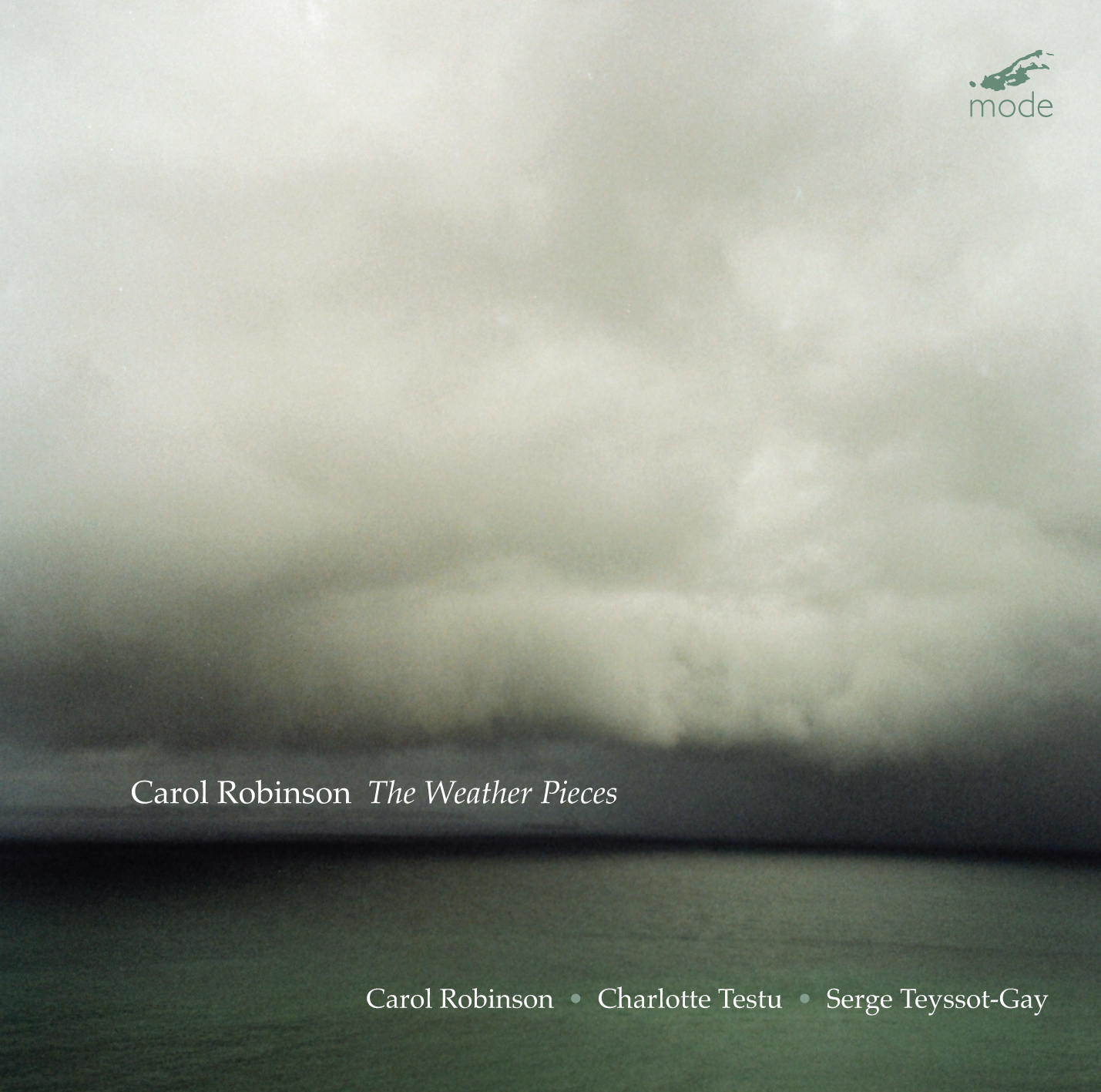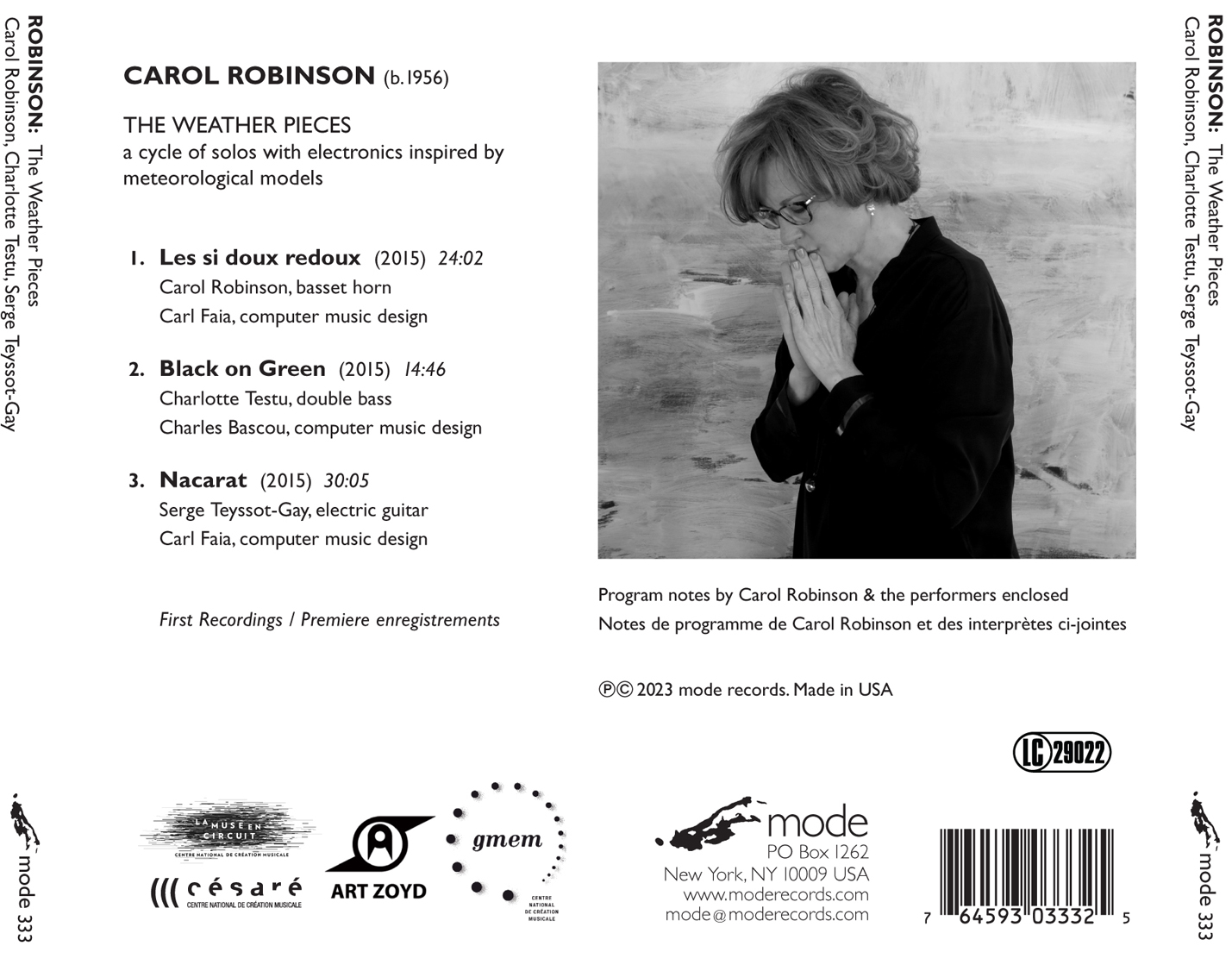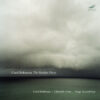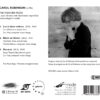Reviews
Bandcamp Best Contemporary Classical Release, July 2023
Veteran clarinetist and composer Carol Robinson, who has gained particular acclaim in recent years for her close work with Éliane Radigue, created the three pieces on this new album back in 2015. Robinson, who has lived in France for decades, grew up in the U.S., including summers in South Dakota, where the volatile intensity and potential devastation of tornadoes left a strong mark upon her. These works are all built around climatological phenomena as expressed through the interactions of an instrumentalist and variable electronic tones reproduced for piece-specific loudspeaker arrays, with each performer occasionally reciting poetic phrases mirroring the imagery driving the piece.
The composer, playing basset horn, tackles the opening piece “Les si doux redoux,” an aural analog of a slight thaw during a cold stretch of winter. As she writes in her liner notes it’s the only piece that doesn’t convey nature’s violence, instead casting an undulating shadow, shimmering in long swoops. “Black on Green,” a piece for bassist Charlotte Testu, is considerably more visceral, conveying the way the sky almost appears green against the dark swirl of clouds as a tornado approaches, delivering a tightly-wound sense of building dread. The apotheosis arrives with “Nacarat,” an epic made for electric guitarist Serge Teyssot-Gay—a veteran rock musician—to conjure the massive scale of a hurricane, passing through furious squalls which surround the relative calm of its eye. Teyssot-Gay has an impressive arsenal of noise and texture at his command, but the structure and the concomitant sounds here feel rather predictable.
— Peter Margasak, Bandcamp, 7 August 2023
https://daily.bandcamp.com/best-contemporary-classical/the-best-contemporary-classical-on-bandcamp-july-2023
The Weather Pieces, the weather of the soul by Carol Robinson
Weather outside, aural weather translated into sound waves, even weather from the depths of the human soul, Carol Robinson’s Weather Pieces are a voyage of initiation. These three pieces explore our sensations, questioning the vital force of the world as well as its inherent danger and death. They take the listener from the world of contemplation, almost meditative, to the heart of chaos.
This disc presents three parts of the cycle The Weather Pieces cycle, in which the composer explores the musical translation of her perception of meteorological phenomena. These works feature three soloists: Carol Robinson herself on basset-horn in Les si doux redoux, double bassist Charlotte Testu in Black on Green , and guitarist Serge Teyssot-Gay in Nacarat. Live, they each play with a simple electroacoustic device, different for each piece: three to four loudspeakers arranged spatially behind or around them, which the record cannot reproduce. The sounds generated by a Max/MSP patch merge with their own instrumental sounds, in a sustained perceptual confusion. Carol Robinson introduces the musicians’ voices, which emerge as “inner thoughts”, as well as an element of randomness that forces a new interpretation each time the work is repeated.
The French expression “le redoux” inspired the composer to write the first piece, which is all restraint and subtlety, variations, half-tones, melting climates and interweaving. The gentle warmth is evoked by the passage from high-pitched, delicate but icy tones to lower, warmer textures. The transition is slow and seamless. This music may evoke the Far East, reminding us of works by Japan’s Tōru Takemitsu (1930-1997), such as In an Automn Garden for gagaku orchestra (1973), which also offers a loving contemplation of nature, without emphasis or clash. The fine embroidery between basset-horn and electronic sounds is not far removed from the effects of the shō mouth organ. The voice, which murmurs at times, is barely perceptible. Extreme concentration transcends the listening experience.
The same energy is found in the introduction to Black and Green, but Charlotte Testu ‘s playing intensifies and is enriched by a myriad of techniques and sonorities, far removed from the smooth textures cultivated in the previous piece. The piece quickly reveals itself to be organic, exploiting in a great crescendo the double bass’s raspy, guttural sonorities, as well as its harmonic feuds. Carol Robinson evokes a memory from her childhood in South Dakota, when the sky turned green and the fast-moving black clouds heralded the coming of tornadoes and danger. The muffled rumble of the evolving electronic framework represents this imminent threat. The whispered French text describes this precise moment of disquieting in-between, which could just as easily be likened to a psychological state.
The noisy textures that end Black and Green also open Nacarat, this time with the fury of a saturated guitar. And with good reason: this piece proposes the crossing of a cyclone! An arched structure, beginning in violence, evolves to the “absolute calm of the eye of the cyclone”, then returns to the initial agitation, pushed to extremes. Serge Teyssot-Gay ‘s mastery of timbres works wonders in this great half-hour voyage, traversed by many colors, themselves enumerated in the text clamored by turns with agitation, disquiet and fascination: “…zinzolin, parma, bright red, turquoise, wheat, plum, wormwood, sapphire, turquoise, yellow, mauve…”, not forgetting “nacarat”, “a shade of both pink and orange, iridescent, not really fixed”, as Carol Robinson describes it in the booklet.
Solidly constructed, the narrative of this album is perfectly conducted by three virtuoso performers of great precision. Having recently had the opportunity to see two of these works performed on stage at the Musique action festival by other performers, double bassist Louis-Michel-Marion and guitarist Christelle Séry (there was also Le fond de l’air II for soprano saxophone, with Violaine Gestalder, and Blanc de neige for trio), I can see that the richness of these scores allows for renewed versions with each performance, and that the disc offers the possibility of highly interesting analytical listening: not always obvious. This focus on meteorological phenomena can only resonate with the emergence of the Anthropocene concept and the growing awareness of the ecological catastrophe generated and maintained by mankind. In this way, Carol Robinson’s album is as much an invitation to contemplate the world’s fascinating and terrible beauties as it is to question their evolution, and perhaps even to imagine the continuity of a world without us.
— Guillaume Kosmicki, hemisphereson.com, 25 July 2023
https://hemisphereson.com/en/the-weather-pieces-the-weather-of-the-soul-by-carol-robinson/
Rachel Yoder. Interview with Clarinetist Carol Robinson. 10 May 2017. Seattle Modern Orchestra.
Paris-based clarinetist and composer Carol Robinson is a contemporary specialist known for her work with the music of Giacinto Scelsi, Morton Feldman, Luigi Nono, and Eliane Radigue. Here she discusses her background, current work, and her upcoming performance with Seattle Modern Orchestra on Mystic Clarinet, a program featuring works by Scelsi, William O. Smith and Jeremy Jolley:
Can you tell us a little about where you grew up and your early musical training?
I lived in many places as a child, but it was in the public school system of Rapid City, South Dakota that I received my initial musical training. This included group lessons, choir and playing in various school bands. Being first chair in the junior high band gave me the opportunity to play with the all-city band and later experience playing in an orchestra. My family moved back to Los Angeles when I was fifteen, and it was there that I began private lessons, working first with John Gates and then most importantly with the great performer and pedagogue Gary Gray. We lived in a neighborhood with a high concentration of people in “the industry” which brought me into contact with all sorts of talented people. The cultural environment was rich and stimulating. When I was sixteen, I went to a music camp called USC-ISOMATA. Once again, I was first clarinet, allowing me to play in the orchestra, chamber music groups and faculty ensembles. That summer, much to the bewilderment of my family, I decided to become a musician.
After graduating from Oberlin, you went to Paris to study contemporary music – what led to your interest in contemporary music?
I have always been interested in unusual sounds, even before I knew what “contemporary music” was. From an early age I played and listened to as much new music as possible. It was IRCAM and a desire to further expand my musical horizons that drew me to Paris.
Was there a particular teacher or mentor in clarinet or composition that you sought out in Paris? Did you train at a conservatory or in another setting?
Before arriving in Paris I spent the summer in Siena, Italy studying at the Accademia Musicale Chigiana. The French clarinetist Michel Portal happened to play a concert there, and hearing him was an inspiration because his approach to the instrument was very different from what I had known until then. I came to Paris just to see what was going on, and upon discovering a vibrant scene, decided to leave the master’s program at USC and stay in the city a while. I was awarded a Harriet Hale Wooley scholarship to study with privately with Portal. Another chance meeting brought me into contact with Maurice Gabai, the principal clarinetist of the Paris Opera. In addition to having brilliant technique, he had a particularly expressive vocal way of playing. I took lessons from him at a regional conservatory off and on for a year and received an advanced performance diploma. These French musicians offered another vision of clarinet playing, and were both important to my musical development.
I understand that you worked with Giacinto Scelsi on his music for clarinet. Can you describe this experience and the performance insights you gained?
If I were to name a master, Giacinto Scelsi would be mine. After visiting him in Rome, a friend brought some clarinet scores back to Paris and gave them to me. The music spoke to me immediately. I soon played the three pieces for E-flat clarinet (Tre Pezzi) in concert. The same friend recorded the concert and sent the tape to Scelsi. He subsequently invited me to work with him in Rome. Sessions with him were intense, not only because he was very exacting regarding the scores, but also for the degree of concentration and raw power required. He demanded total involvement, settling for nothing less. Every instant of every note mattered. Those lessons have never left me.
You’ve recorded an album of Scelsi’s music, and two of his works are programmed on the upcoming concert with Seattle Modern Orchestra. What drew you to his music, and can you describe some of your favorite aspects of these works?
I’ll be performing Kya, and coaching two SMO musicians on the stunning Ko-Lhoduet for flute and clarinet. I love the power of this music, its urgency and gripping emotional impact. I have always been fascinated by how it sounds simultaneously archaic and ultra-modern.
One of my favorite things about Scelsi is his use of microtones, intervals smaller than the half-steps we typically find in Western music. How do you think this technique affects the listener, and what challenges does it create for the performer(s)?
Microtones, like glissandi, create shifts in the perception of time. They help us slip into another listening reality. Modern orchestral wind instruments were designed with elaborate key mechanisms to play diatonically. These mechanical systems for an instrument like the clarinet can be ill-adapted to producing smaller intervals, and in addition to being imprecise, are often plagued by timbral differences.
On the SMO concert, you’ll also be performing a work by Seattle-based clarinetist and composer William O. (Bill) Smith, who is widely known both as a jazz musician who performed with Dave Brubeck and as a pioneer of extended techniques for the clarinet. What do you see as Smith’s legacy to clarinetists?
Bill Smith’s lasting legacy will be his pioneering work with clarinet multiphonics [multiple notes at once]. His diligence in defining and cataloguing these sounds has opened untold possibilities for generations of clarinetists and composers. Though perhaps less widely known, his compositional exploration of the demi-clarinet, double-clarinet, “prepared” clarinet [using assorted accessories and modifications] and integrated electronics has likewise left its mark. His personal performance practice also includes the use of projections, hand gestures, texts and simple staging. He is a truly inventive and generous person.
Why did you choose to perform this particular Smith piece (Rites for clarinet and tape)?
Rites was written for me, commissioned by the CCMIX (formerly Xenakis’ UPIC studio) in Paris, as part of an multi-composition project for clarinet and electronics. Playing it in Seattle with the composer present is a real honor.
What other composers have you worked with closely?
Though I have worked with many composers over the years, perhaps most important is my ongoing collaboration with the French electronic master Eliane Radigue.
Your mesmerizing album Billows for clarinet and live electronics strikes me as exploring the visceral, mystical territory of Scelsi but with the slower pace and simplicity of Morton Feldman, another composer whose works you’ve performed and recorded. Then there’s the birbyne, a Lithuanian single-reed instrument you use on the album. Can you speak to how your musical influences and interests play out in your compositions?
I suppose that it is normal for there to be parallels between what I prefer to play, and the music I write, though there is no intentional overlap. There is something so physical in the perception and creation of sound, something almost integrated into the psyche. How could they not be mutually influential?
Billows grew out of the quiet section of long, very contrasted work for basset horn and electronics. The idea for it came from a record producer who, fascinated by that slow, floating section, wanted to release a complete CD with only that. The special open timbre of the birbyne was especially well-suited to the live electronic treatment I was working with.
What current or upcoming compositional and performing projects are you working on?
Upcoming compositional projects include a 13-minute piece for solo percussion and electronics, a duet for birbyne and voice, and a piece for string trio and electronics which will be part of my cycle THE WEATHER PIECES, inspired by meteorological phenomena.
In addition to performances of my own music, there will be a premiere of a new opera by Wandelweiser composer Jürg Frey in Ireland, and a new work for birbyne and harp by Eliane Radigue for the Venice biennial.
A longer-term project is recording a CD of new works for birbyne by various wonderful composers.
Anything else you’d like to add?
I’m very happy to be playing this program in Seattle!
Hear Carol Robinson perform works of Scelsi, Smith and Jolley with Seattle Modern Orchestra on June 3 at the Good Shepherd Center in Seattle, WA (more info/tickets). To learn more about Robinson, visit her website.




